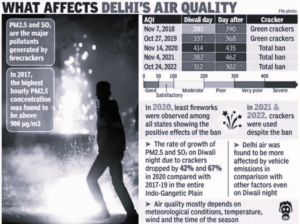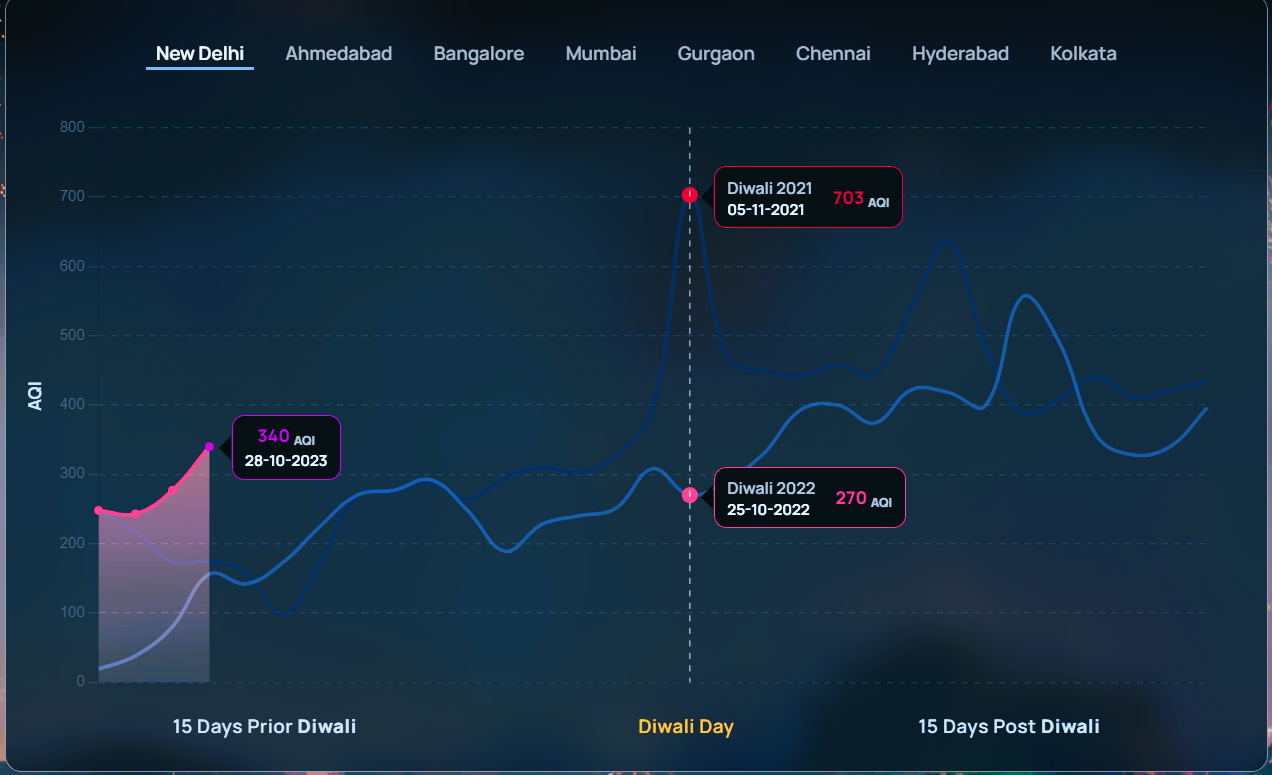
Noida, and Gurugram are in the grip of ‘Very Poor’ to ‘Poor’ air quality, with Air Quality Index (AQI) ranging from 221 to 341, sounding the alarm for residents in the National Capital Region (NCR). Despite a 15-point winter action plan to curb the rising pollution, the battle against deteriorating air quality continues.
While initiatives like ‘Red Light on, Gaadi off’ are in motion as vehicular and biomass burning emissions contribute to rising PM2.5 levels, the haze is likely to linger, with ‘Very Poor’ air quality forecast for the region from October 29 to 31, 2023.
The overall air quality in the national capital on Sunday was recorded in the ‘Very Poor’ category, as per the System of Air Quality and Weather Forecasting and Research (SAFAR)-India. The AQI in Delhi was recorded at 309 on Sunday morning. As per the latest data from SAFAR-India, the air quality around Delhi University was recorded at 341 (Very Poor) in the morning hours while in IIT area it was recorded at 300.
Similarly, in Lodhi Road area it was recorded at 262 in the ‘Poor’ category. India Meteorological Department (IMD) in its bulletin on Delhi’s Air Quality forecasted predominant surface wind likely from variable directions in Delhi with wind speed 04-08 kmph, resulting in mainly clear sky and mist in the morning on October 29.
Also, coming under the ‘Poor’ category, the IIT Delhi region recorded an AQI of 300 and in the Mathura Road area, it was recorded at 228. The quality of air at the Airport (T3) was in the ‘Very Poor’ category, with an AQI of 323.
Meanwhile, Noida recorded an AQI of 317 (Very Poor) and Gurugram 221 (Poor). Earlier on Friday, Delhi Environment Minister Gopal Rai said that a 15-point winter action plan is being implemented one by one to curb the pollution. “Delhi Chief Minister Arvind Kejriwal had earlier announced a 15-point winter action plan to curb the pollution caused by vehicles, biomass burning, dust, etc. Now this winter action plan is being implemented on the ground one by one to reduce the pollution in the national capital,” Rai.
The Delhi Minister said that since one of the major causes of the pollution is vehicles, they have started the ‘Red Light on, Gaadi off’ campaign on Thursday. “Now the data says that in AQI the level of Particulate matter (PM) 10 is decreasing and that of PM2.5 is increasing. This means that pollution caused by vehicles and biomass burning is increasing. For this, the ‘Red Light on, Gaadi off’ campaign has been started,” the Delhi Minister said.
Since 2020, Diwali nights have been a bit quieter. Fireworks were prohibited that year to combat pollution, a restriction that Environment Minister Gopal Rai reaffirmed for the 2023 festival season on Monday.
According to the PGIMER study, PM2.5 and sulphur dioxide (SO2) emerged as the primary pollutants stemming from firecrackers. Surprisingly, there was no impact on the ozone levels, contrary to previous beliefs. The increase in PM2.5 and SO2 attributed to firecrackers decreased significantly by 42% and 67% on Diwali night in 2020 when compared to the period from 2017 to 2019, across the entire Indo-Gangetic Plain, owing to the windy conditions.
“For Delhi, it’s all about the meteorological conditions,” explained Chandra Bhushan, CEO, International Forum for Environment, Sustainability and Technology (iForest). “The good air of recent days is largely because there have been more rainy days. The number of days with better air quality is always in proportion to rainy and windy days. This means that the weather condition is the single most important factor in the pollution level in the city.”
While acknowledging the importance of banning fireworks as a “civic duty,” Bhushan pointed out that if particle pollutants have indeed fallen by 42% in recent years, as claimed by the state government, it is not solely due to the fireworks ban. Bhushan emphasized the need for additional measures, particularly in winter, such as discouraging the burning of waste and biomass for heating by providing electric heaters to those in need.























